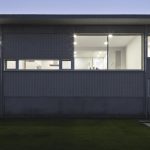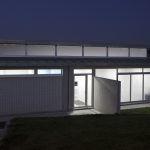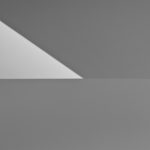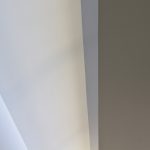Year
2018
Location
Urbanización Breogán, Feáns, A Coruña.
Latitude: 43º 18′ 46,63” N
Longitude: 8º 26′ 44,30” W
Promoter
Julio Souto Martínez
Arquitects
Fermín González Blanco
Luis Miguel Fernández López
Team member
Saúl Gómez Rubio
Building engineer
Calcugal
Javier López Da Vila
Construction
Desarrolla
Jose Santiso Vázquez
José Manuel Maneiro Rivas
Rubén García Polo
Pictures
Roi Alonso. www.roialonso.com
Budget
215.328,40 euros
[/wpcol_1third]

Between urban and rural.
Between the sea and the mountains.
Between the views to the north and the sun to the south.
Between the sea wind and the protected area.
Between the access and the road at the top and the plot at the bottom.
Between the neighbor on the right and the one coming from the left.
Between the neighbor who is building to the north and the neighbor who will build to the south.
Between promoters and friends.
Between 1 young couple, 2 dogs and 2 cats.
Between 215,328.39 and 215,328.41 euros.
Between De la Sota, Utzon and Don Andrés Albalat.
Between the sleeping-dressing-bathroom space and the general rooms-bathroom block.
Between not seeing the urbanization and seeing the city, the Tower of Hercules and the sea.
Between the desired intimacy and the necessary warmth and light.
Between the north strip of the house and the south strip.
Between a skylight and a passive heating system.
Between a floating zinc roof + self-protected sheet metal and a concrete wall base.
Between a continuous window and a crazy catalogue of carpentries.
Between the Rudolph concrete block and a porticoed exposed concrete structure.
Between linoleum floors, exposed concrete pillars and white envelopes.
And between the project and the work, one more, Lia./em>
Project for a single-family house on a plot of land located in the Breogan urbanization, on a hillside near the village of Feáns. Plot nº9 of the street Isidro Parga Pondal located in the highest part of the urbanization, with favorable conditions of sunshine and views over the rest of the urbanization and the city of A Coruña.
Oriented along the northeast-southwest axis, it has a marked topography with a difference in height of 8 metres between the upper part of the access and the lower limit. There is a constant wind that is characteristic of a valley facing the sea. It is situated on urban land for residential use and has alignment, connection to facilities and access from the top. Only drainage is carried out by gravity to the bottom of the plot. It has a gross surface area of 1071.85 m², giving the public road in the access area a surface area of 22.5 m². Sensitively rectangular (42 x 25 meters).
It is located in one of the last stages of development of the urbanization in which there are still free plots, being the previous phases already consolidated with a mixture of housing developments and particular initiatives such as the one we are dealing with. The relatively recent opening of the third Ronda and the passing of the current economic crisis have revived interest in this area of the city. Currently, and after the construction of this house, work has begun on three more plots in this same area of the urbanization where there are still plots available.
_
PROGRAMME
The programme (225.9 m² gross floor area) is mainly resolved on the ground floor (164.0 m² gross floor area) by sending the technical areas such as the boiler room, the storage rooms and the washing and drying areas to two small semi-basement areas (61.9 m² gross floor area). On the ground floor there are the common areas in the central part of the house (kitchen, dining room, living room and entrance) and there are two bedroom areas surrounding the central part of the house, consisting of two single bedrooms and a general bathroom on one side and a master bedroom with bathroom and dressing room on the other side of the house. The program is completed with a small exterior terrace that allows a second lateral access so that it is possible to operate one of the rooms as a studio. An interior courtyard on the east side of the house allows for ventilation and lighting of the laundry areas on the semi-basement floor and the bathroom in the master bedroom.
_
APPROACHES
Copy vs. Original
This useless debate (at least for the promoters) is flown over with work. The solution is found in floor version 16 and the solution is found in section version 5. After receiving the order on 26/02/14 the basic project is ready on 17/06/14, receiving the approval of the promoters and having passed through the versions reflected in the attached plans.
Typological prototype
EThe result of the work carried out is a direct consequence of the characteristics and problems encountered. Plot in the middle of an urbanization, sloping, facing a sea that is to the north and receiving the sun from the south, economic, compact, etc. The set of determining factors makes this proposal a prototype extrapolable to a good part of the Galician coast, to the whole of the Cantabrian coast and to the world.
Affordable Housing
The economy starts in the project, not in a database, neither through intermediaries, nor through a combat of economic offers. The approach to housing is based on the economic conditions imposed. The compactness of the house or the adaptation to the terrain are basic when it comes to containing the costs of it. The materials chosen or the technological level used are also fundamentally economic decisions. Reinforced concrete and concrete block enclosures are chosen in the knowledge that they are widely standardised and dominated by a multitude of companies. Also contributing to the economic end are certain sacrifices made by the developers themselves, such as giving up the garage. The objective is to build a house for the price of a flat in the city that meets the required program.
To see without being seen
Receive natural light and warmth in all the rooms without witnessing the urbanizing disaster of the surroundings. To catch what is of interest and reject everything else. There are two bedroom areas on either side of the large central area of the house where the common spaces are located. These bedrooms, due to their own conditions and needs, are mainly built opaque, with high, narrow windows in the crowning of the walls. In this way they serve as filter elements and a sifted relationship with the neighbours on the left and right. In this sense, the very envelope of the dwelling is also a narrative constructed of what is intended to be seen and what is rejected.
Continuous Window
The enclosure of the house is built as a dialogue between the opaque and the glazed. It is a continuous window that surrounds the entire house (except for a small section in the bathroom area of the main bedroom) and varies in position and size according to the needs of transparency, sunshine and privacy. This continuity enhances the idea of a floating roof and allows a diagonal transparency from the living room of the house in the south and the large window located in the dining room overlooking the city and the sea.
All equal
The self-imposed premise that all rooms have a direct view of the valley and the city and all receive direct sunlight from the south is met. There are no privileged rooms in either position or useful surface area. The children’s rooms are as important as the parents’ rooms, or more. The kitchen and dining area is recessed 5 steps, making it possible to see over this area from the living room. Only the vision of the city (not the direct light or ventilation) is denied to both bathrooms and the dressing room.
Structure as architecture and architecture as structure
The approach to housing and its conditioning factors are closely related to the resistant structure. The structure is designed as a base of concrete walls that house the technical areas of the dwelling, on which four porticoes that run longitudinally and in parallel through the dwelling are erected. The four pillars of the south façade vary in position and number until they remain two on the north façade to allow a view of the valley and the city. Four main concrete beams are arranged on these columns, between which the two areas of unidirectional slab and eaves of concrete slab formwork on melamine panels are resolved. And between these two forged areas a skylight with metal profiles and wooden boards that illuminate the central area of the house. Architecture, or at least its functioning, must be able to be understood through the structure of the building. v
More than a skylight
The ground floor programme is divided into two strips arranged in parallel and crossed by a central skylight on the roof that allows the kitchen and dining room areas to be illuminated directly from the south and provides transparency and a visual connection with the outside to the central area of the dwelling. In this way, transparencies are established in the two axes of the dwelling that relate it simultaneously to the city and the plot. Apart from spatial issues, the skylight works as a passive air heating system contributing to the heating of the house in winter.
Overhangs for all seasons
The roof eaves of the house and the central skylight of the house are extended and dimensioned to protect the house from excessive heat in summer and also from excessive rain in winter.
Horizontal and vertical
The horizontality marked by the eaves of the roof and the skylight is superimposed on the verticality imposed by the exposed concrete pillars. It was decided to extend this verticality through the walls of the enclosure through the texture and the lines of shade generated by the Rudolph concrete blocks used in the building. These concrete blocks present in Don Andrés Albalat’s studio (close to this office) served to convince the promoters of their use in this work after a short visit to see and touch the material on a large cloth. In spite of the samples of material requested by the office, the presence of already constructed elements where the system can be evaluated becomes essential.
Set of blocks
Verticality, chiaroscuro and continuity of the enclosure are pursued. Due to the impossibility of using large-sized prefabricated structures due to the economic conditions of the project, small prefabricated structures in the form of Rudolph-type fair-faced concrete blocks are used. This 397x194x195 mm white concrete block has a vertical texture on its exposed face made up of three 1 cm wide grooves and four prisms with rounded edges. In this way, the horizontal joints of 1 cm thick and the vertical joints of the minimum possible thickness are executed, the view of the traditional block wall is lost to some extent and the enclosure becomes a continuous and homogeneous cloth. The block offers 6 variants: one-sided textured block, two-sided textured block, one-sided textured block, two-sided textured block, one-sided textured plate and two-sided textured corner plate. The placement of the block is considered leaving its cushioned forms in cantilever and supporting the rest of the block on the resistant elements. With these pieces and with the above criteria, the construction of the facade walls becomes a game.
_
MATERIALITY
Structure
Most of the ground floor flooring is built with a ventilated caviti-type floor screed, resolving the floors in a semi-basement with 20 cm thick walls and reinforced concrete pillars on which a one-way slab of prestressed joist and 15+5 cm thick concrete vault rests. The roof is resolved with this same slab supported by four beams arranged longitudinally and reinforced concrete slabs formed on melamine boards in the roof eaves. The roof of the skylight is made with a structure of laminated steel columns, beams and straps and wooden decking.
Enclosure
The house has a homogeneous façade finish composed of the structure itself made of reinforced fair-faced concrete in walls, pillars and beams, resolving the vertical enclosures with a 19 cm thick white water-repellent fair-faced concrete block type Rudolph. A ventilated air chamber is designed through vertical joints between blocks without mortar, 10 cm of thermal insulation based on extruded polystyrene sheets and a double hollow brick sheet plastered and painted with white plastic paint.
Floors are solved on a ventilated caviti type floor screed or on a unidirectional floor slab using a 3 cm thick insulation sheet and a 7 cm thick radiant floor, on which a levelling paste is applied and a linoleum floor is installed.
The roof of the skylight is resolved with self-protected waterproofing sheet welded over the wooden decking, 15 cm of insulation based on rock wool blankets and a lower finish of laminated plasterboard painted with white plastic paint.
The roof is resolved by the use of a unidirectional slab. An extruded polystyrene insulation sheet is placed on top of it and a green, self-protected waterproofing sheet is welded onto it. Underneath, insulation of 10 cm thick rock wool blankets and false ceiling of plasterboard panels painted white. The eaves and the perimeter trims are resolved with a zinc cover over a sheet of polyethylene nodules and a waterproof wooden board anchored to the structure.
Urbanización
A garden is projected in the elevation towards the access road allowing a natural extension of the house towards the sun and acting as a filter towards the street and the neighbours. At present we are still fighting, trying to convince the developers to undertake the planting of species on the perimeter of the plot closure, to achieve the second privacy filter so necessary for a home.

























































